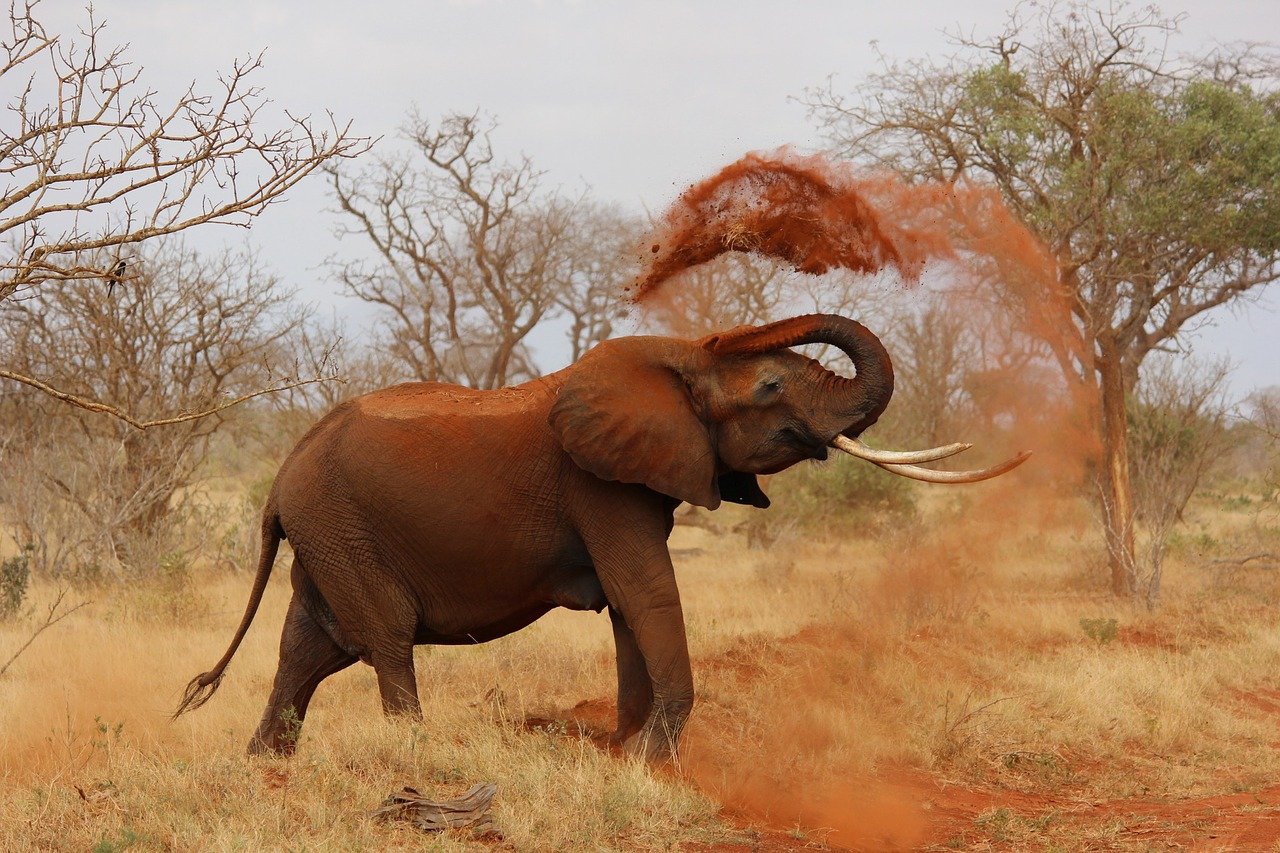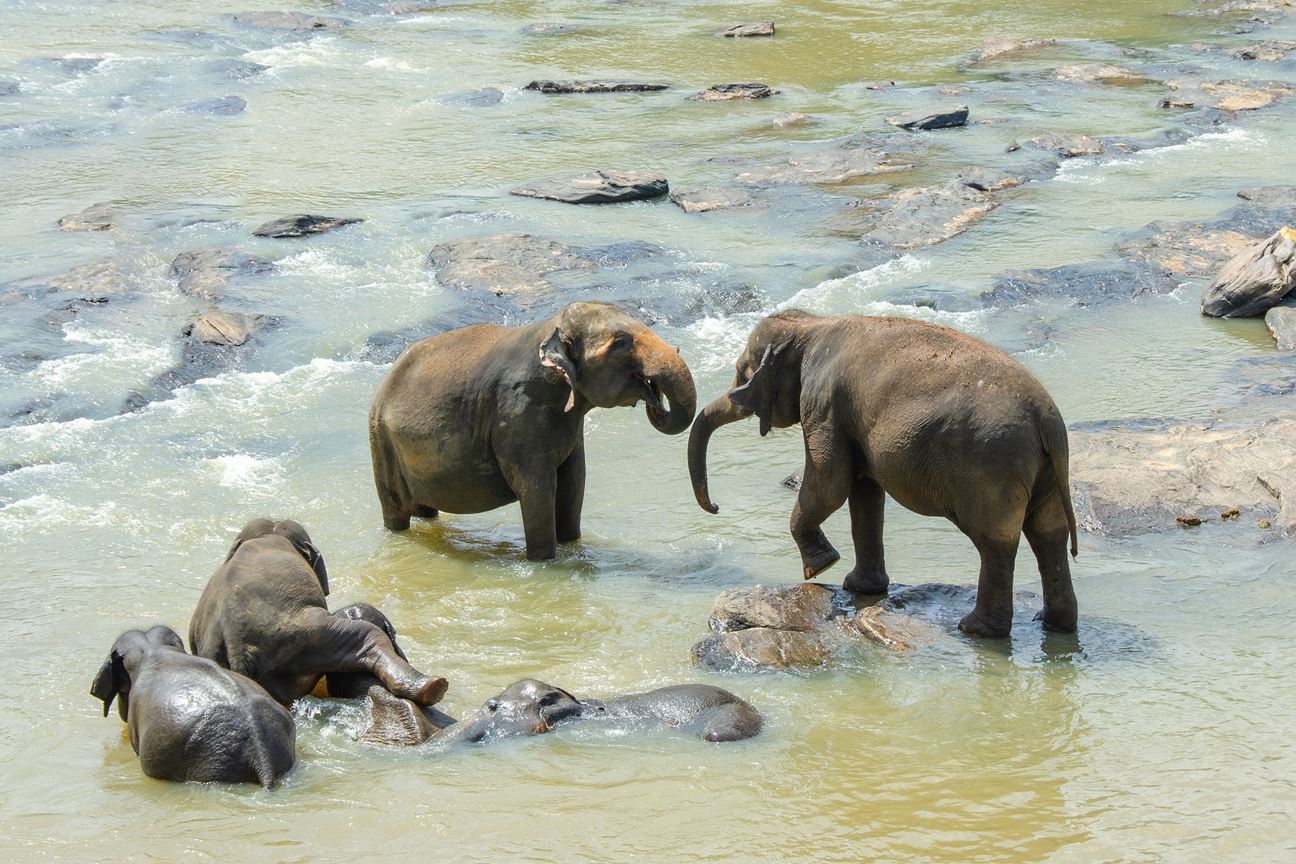The number of differences between Asian and African Elephants is remarkable. Some subtle, some more obvious. Let’s find out!
Elephants are the biggest animals to walk on earth. Authoritative when they walk, elephants are a symbol of wisdom and compassion. Their trunks, like a periscope, also doubles for a helping hand, columnar legs pressing into the earth provide poise, and their massive bodies - a marvellous creation.

An African Elephant with its distinctive 'big' ears
Today, art and statistical reconstruction prove that elephants have existed for almost 50 to 60 million years on earth; ironically, their ancestors were only the size of a pig. To adapt or go extinct - was the question. They evolved with time to look the way they look today, all thanks to their bigger brains.
Of the many elephant species found on earth today, the most prominent and dominant are the African Elephants and the Asian Elephants, who both belong to the family Elephantidae. However, they differ from each other in their habitat, body shape, size and behaviour, among others. The African Elephant species (genus: Loxodonta) is further divided into the African Bush (also Savannah) Elephant and the comparatively smaller African Forest elephant. The Asian Elephant (genus Elephas Maximus) found in Asia is closely related to the now-extinct mammoth. While both the species of elephant come from the same family, these two are geographically distinct.
Geographic Distribution
When it comes to the ancient historic range of the African Elephants, they were found throughout the continent of Africa, except for the Sahara desert. By the end of the middle ages, these elephants started to disappear from Northern Africa. Currently, the Savannah Elephant can be found in areas of Central, East, and Southern Africa, whereas the Forest Elephant can be found in Western parts of Africa and the Congo Basin.
As for the Asian Elephants, their historic range was limited to the Indian Subcontinent, South and Southeast Asia, Tigris and Euphrates River (eastward through Persia), and China (up to the Yangtze-Kiang). Currently, these elephants can be found in the Indian Subcontinent, Continental Southeast Asia, and the Asian islands (Andaman and Nicobar, Sri Lanka, Borneo, and Sumatra). India is home to 60% of the wild elephant population.
Habitat
Ecologically, both the subspecies of the African Elephants occupy different habitats. Bush elephants occupy savanna, flood plains, montane and lowland forests, and woodlands. On the other hand, the forest elephants occupy most rainforests, especially the semi-deciduous forests.
The Asian Elephants are found in the tropical and subtropical forests. These elephants prefer to transit between the ecological zones and are found moving through forests and grasslands vegetation as the seasons change. Given their wide distribution, the Asian elephants are known to occupy a range of habitats such as moist deciduous forests, wet evergreen forests, swampy grasslands, dry deciduous woodland, grassland, and marshes. The elephants that live on the Andaman Islands are spotted swimming across the sea to move the islands.
 An African Bush elephant in the wild
An African Bush elephant in the wild
Body Built and General Appearance
The African Elephants are considered being the largest living land mammals - The length between the tip of their trunk and the tip of the tail measures a whopping average of 8 metres! The Savannah elephants are more ‘slender’ with concave backs, while the forest elephants are more ‘compact’ with straight backs. These elephants have very large ears - twice the size of their Asian counterparts. The ears help them in social interaction and also provide balance. They have poor eyesight but see best in dim light. The trunks of African Elephants are as long as 6 feet, can weigh between 150 to 200 kgs, and have two prehensile fingers at the tip. Their functions include lifting objects, smelling, spraying, and inhaling. Their single pair of tusks eventually harden into ivory. In case of Savannah elephants, the tusks are curved out and point forward, but with forest elephants, the tusks point down - straight to the ground. The skin of the African Elephants is typically grey, with varying thickness and sparse hair all over the body.
On the other hand, Asian Elephants are smaller than the African Elephants. Their ears are also smaller and are often used for thermoregulation. In relation to its body size, these elephants have tiny eyes and can see best in dim lighting conditions. They can also see and differentiate between a few colours. Their trunks have more annulations (rings) compared to the African Elephants and are also more extendable. While the functions of the trunks are like African Elephants', these elephants have only one prehensile finger at the tip, similar to mammoths. Trunks are slimmer and straighter compared to their African counterparts. Male elephants usually prefer either of the tusks — the left or the right — and so one tusk shows more wear and tear compared to the other. Female Asian Elephants are tuskless but have tushes.
 A female Asian elephant and its calf
A female Asian elephant and its calf
Physical Attributes
African Elephants
| | Savannah (or bush) Elephant | Forest Elephant |
| Atribute | Male | Female | Male | Female |
| Body Weight | 4000 -6500 kgs | 2500 - 3500 kgs | 2800 - 5800 kgs | 2800 - 5800 kgs |
| Shoulder Height | 3.5 - 4 mts | 2.3 - 2.5 mts | 2.5 - 2.9 mts | 1.9 - 2.5 mts |
| Body Lenght | 3 - 5 mts | 3 - 5 mts | 3 - 4 mts | 3 - 4 mts |
| Tail Lenght | 1 - 1.5 mts | 1 - 1.5 mts | 50 - 120 cms | 50 - 120 cms |
Asian Elephants
| Atribute | Male | Female |
| Body Weight | 2500 - 5500 kgs | 2500 - 5500 kgs |
| Shoulder Height | 5.5 - 6.5 mts | 5.5 - 6.5 mts |
| Body Lenght | 1.1 - 1.4 mts | 1.1 - 1.4 mts |
| Tail Lenght | 3.2 mts | 2.5 mts |
Activity Cycle
Feeding takes up most part of the day. The African Elephants are known to graze and feed for almost 16 hours a day! They sleep for an average of 4.5 hours a day. As for the Asian Elephants, they spend over 80% of the day feeding. The rest of the elephant activities like walking, resting, bathing, and drinking takes up very little time for both the species.
Social Groups
The African Elephants follow a matriarchal social structure that includes a matriarch, her offspring, and her sisters. The Savannah/bush elephants are seen in extended family groups (between 5 to 15) while the forest elephants are seen in nuclear groups (2 to 4). Males leave the family group as they reach their teenage years. The tallest elephant usually takes up the place of the ‘head’ of the group. With Asian Elephants, the head of the group is typically the eldest female. This group is also matriarchal, comprising about 8-10 individuals.
 Sri Lankan elephants in a playful mood
Sri Lankan elephants in a playful mood
Movement and Speed
Both the African and Asian elephant species are quadrupedal. The African Elephants typically walk, moving at a speed of 6 to 8 kilometres/hour. They can reach a top speed of 40 kilometres/hour. Proficient swimmer, these elephants can cover distances up to 50 kilometres at a stretch.
The Asian Elephants are amazing swimmers too! On land, they move at a speed of 4 to 6 kilometres/hour. They both run only when in attack mode.
Diet
When it comes to consuming food, both the African and Asian elephants are vegetarian herbivores. However, there are subtle differences in their eating patterns. The African Elephants feed on over 80 plant species - the Savannah elephants primarily consume grasses, sedges, forbs, and other woody vegetation, while the forest elephants consume fruits, seeds, leaves, bark, and branches. Adults consume 4 - 6% of their body weight daily, which is approximately 100 - 150 kgs of food and drink an average of 130 litres of water daily.
The Asian Elephants feed on over 100 different plant species. The elephants in Malaysia are known to consume more than 410 plant species! Their choices of plants vary with seasons and vegetation. Adults consume between 2 and 4 per cent of their body weight and can drink over 200 litres of water!
Reproduction
While both the elephant species have similar sexual and courtship behaviour, their gestation periods can slightly differ. The African Elephants have a gestation period of an average of 22 months, with an inter-birth interval ranging between 4 to 6 years. The Asian Elephants have an average of 20 months of the gestation period, and their inter-birth interval can range between 2.5 to 4 years.
Longevity
It is estimated that male African Elephants in the wild can survive up to 60 years of age on average. Females survive up to 40 years on average. An Asian Elephant’s longevity is comparable to human life and can live up to 70 years in the wild.
Population and Conservation
The best available estimate says there are about 400,000 African Elephants in the wild. The possibility of another 120,000 individuals cannot be ruled out. Ivory poaching has been the primary reason for the decline in the elephant population all over Africa. IUCN status for African Elephants remains vulnerable. Of all the Asian Elephants surveyed, over 50% are found in India. There are a lot of approximately 45,000 Asian elephants in the wild. These elephants are endangered as per their IUCN status, while the Sumatran elephant subspecies remain critically endangered.